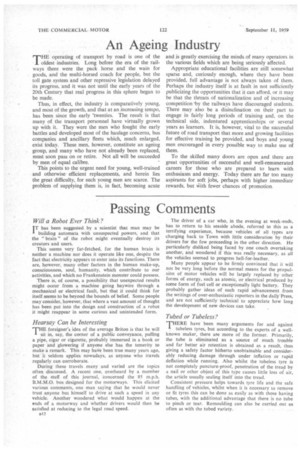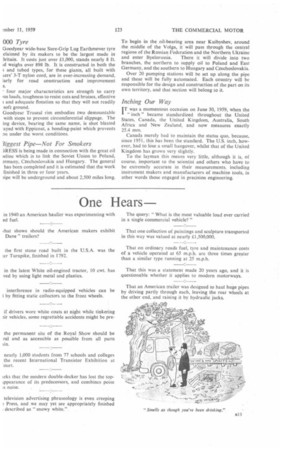Passing Comments
Page 46

Page 47

If you've noticed an error in this article please click here to report it so we can fix it.
Will a Robot Ever Think?
IT has been suggested by a scientist that man may be building automata with unsuspected powers, and that the " brain" of the robot might eventually destroy its creators and users.
This seems very far-fetched, for the human brain is neither a machine nor does it operate like one, despite the fact that electricity appears to enter into its functions. There are, however, many other factors in the human make-up, consciousness, soul, humanity, which contribute to our activities, and which no Frankenstein monster could possess.
There is, of course, a possibility that unexpected results might occur from a machine going haywire through a mechanical or electrical fault, but that it could think for itself seems to be beyond the bounds of belief. Some people may consider, however, that where a vast amount of thought has been put into the design and construction of a robot it might reappear in some curious and unintended form.
Hearsay Can be Interesting
THE foreigner's idea of the average Briton is that he will .sit in, say, the corner of a public conveyance, puffing a pipe, cigar or cigarette, Probably immersed in a book or paper and glowering if anyone else has the temerity to make a remark. This may have been true many years ago, but it seldom applies nowadays, as anyone who travels regularly can corroborate.
During these travels many and varied are the topics often discussed. A recent one, overheard by a member of the staff of this journal, concerned the 85 m.p.h. B.M.M.O. bus designed for the motorways. This elicited various comments, one man saying that he would never trust anyone but himself to drive at such a speed in any vehicle. Another wondered what would happen at the ends of a motorway and whether drivers would then be
satisfied at reducing to the legal road speed. • al 2
The driver of a car who, in the evening at week-ends, has to return to his seaside abode, referred to this as a terrifying experience, because vehicles of all types are charging back to Town with little consideration by their drivers for the few proceeding in the other direction. He particularly disliked being faced by one coach overtaking another, and wondered if this was really necessary, as all the vehicles seemed to progress hell-for-leather.
Many people appear to be firmly convinced that it will not be very long before the normal means for the propulsion of motor vehicles will be largely replaced by other forms of energy, such as atomic, or electrical produced by some form of fuel cell or exceptionally light battery. They probably gather ideas of such rapid advancement from the writings of over-enthusiastic reporters in the daily Press, and are not sufficiently technical to appreciate how long the development of new devices can take.
Tubed or Tubeless?
]'HERE have been many arguments for and against
tubeless tyres, but according to the experts of a wellknown maker, there are more of the former. Primarily, the tube is eliminated as a source of much trouble and far better air retention is obtained as a result, thus giving a safety factor hitherto unobtainable and considerably reducing damage through under inflation or rapid deflation while running. Also whilst the tubeless tyre is not completely puncture-proof, penetration of the tread by a nail or other object of this type causes little loss of air, the article usually sealing itself into the tread.
Consistent pressure helps towards tyre life and the safe handling of vehicles, whilst when it is necessary to remove or fit tyres this can be done as easily as with those having tubes, with the additional advantage that there is no tube to pinch or teat. Remoulding can also be carried out as often as with the tubed variety.
000 Tyre
Goodyear wide-base Sure-Grip Lug Earthmover tyre claimed by its makers to be the largest made in 3ritain. It costs just over £1,000, stands nearly 8 ft. id weighs over 898 lb. It is constructed in both the ; and tubed types, for these giants, all built with ters' 3-T nylon cord, are in ever-increasing demand, any for road construction and improvement S.
four major characteristics are strength to carry ins loads, toughness to resist cuts and bruises, effective and adequate flotation so that they will not readily soft ground.
Goodyear Truseal rim embodies two demountable with stops to prevent circumferential slippage. The ing device, bearing the same name, is shot blasted ayed with Eppicoat, a bonding-paint which prevents pn under the worst conditions.
3iggest Pipe—Not For Smokers
MESS is being made in connection with the great oil 'elute which is to link the Soviet Union to Poland, .rmany, Czechoslovakia and Hungary. The general has been completed and it is estimated that the work finished in three or four years.
)ipe will be underground and about 2.500 miles long. To begin in the oil-bearing area near Kuibyshev, around the middle of the Volga, it will pass through the central regions of the Russian Federation and the Northern Ukraine and enter Byelorussia. There it will divide into two branches, the northern to supply oil to Poland and East Germany, and the southern to Hungary and Czechoslovakia.
Over 20 pumping stations will be set up along the pipe and these will be fully automated. Each country will be responsible for the design and construction of the part on its own territory, and that section will belong to it.
Inching Our Way
IT was a momentous occasion on June 30, 1959, when the " inch " became standardized throughout the United States, Canada, the United Kingdom, Australia, South Africa and New Zealand, and now measures exactly 25.4 mm.
Canada merely had to maintain the status quo, because, since 1951, this has been the standard. The U.S. inch, however, had to lase a small hangover, whilst that of the United Kingdom has grown very slightly.
To the layman this means very little, although it is, of course, important to the scientist and others who have to be extremely accurate in their measurements, including instrument makers and manufacturers of machine tools, in other words those engaged in precision engineering.




























































































































































